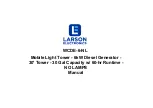
INSTALLATION
Page
26
Copyright
Trace Engineering Company, Inc.
5916 - 195th Street N. E.
Arlington, WA 98223
Telephone: 360/435-8826
Fax: 360/435-2229
www.traceengineering.com
SW Series Inverter/Charger
Part No. 2031-5
Rev. B: Sept 1, 1999
SYSTEM GROUNDING
GROUNDING INSTRUCTIONS - This inverter/charger should be connected to a grounded, permanent
wiring system. For most installations, the negative battery conductor should be bonded to the grounding
system at one (and only one point) in the system. The subject is more easily discussed if it is divided into
three separate subjects; Chassis Ground, Ground Rods and Bonding. The grounding requirements vary
by country and application. All installations should comply with national and local codes and ordinances.
Even system designers and electricians often misunderstand system grounding. Consult local codes and
the NEC for specific requirements. Refer to Table 15, page 133 for safety ground wire sizes.
EQUIPMENT OR CHASSIS GROUNDS
This is the simplest part of grounding. The idea is to connect the metallic chassis of the various
enclosures together to have them at the same voltage potential, which reduces the possibility for electric
shock. It also provides a path for fault currents to flow through to blow fuses or trip circuit breakers. The
size of the connecting conductors should be coordinated with the size of the overcurrent devices involved.
Under some circumstances, the conduit and enclosures themselves will provide the current paths.
GROUNDING ELECTRODES/GROUND RODS
The purpose of the grounding electrode (often called a ground rod) is to “bleed” off any electrical charge
that may accumulate in the electrical system and to provide a path for “induced electromagnetic energy” or
lightning to be dissipated. The size for the conductor to the grounding electrode or grounding system is
usually based on the size of the largest conductor in the system. Most systems use a 5/8” (16 mm) copper
plated rod 6 feet (2 meters) long driven into the earth as grounding electrode. It is also common to use
copper wire placed in the concrete foundation of the building as a grounding system. Either method may
be acceptable, but the local code will prevail. Connection to the ground electrode should be done with
special clamps located above ground where they can be periodically inspected.
Many large systems use multiple ground rods. The most common example is providing a direct path from
the solar array to earth near the location of the solar array. Most electrical codes want to see the multiple
ground rods connected by a separate wire with its own set of clamps. If this is done, it is a good idea to
make the connection with a bare wire located outside of the conduit (if used) in a trench. The run of buried
wire may be a better grounding electrode than the ground rods! Well casings and water pipes can also be
used as grounding electrodes. Under no circumstance should a gas pipe or line be used. Consult local
codes and the NEC for more information.
BONDING THE GROUNDING SYSTEM
This is the most confusing part of grounding. The idea is to connect one of the current carrying conductors
(usually the AC neutral and DC negative) to the grounding system. This connection is why we call one of
the wires “neutral” in the North American type electrical systems. You can touch this wire and the
grounding system and not be shocked. When the other ungrounded conductor (the hot or positive)
touches the grounding system, current will flow through it to the point of connection to the grounded
conductor and back to the source. This will cause the overcurrent protection to stop the flow of current,
protecting the system. This point of connection between the grounding system (ground rod, vehicle
frame, boat hull, etc.), the current carrying grounded conductor (AC neutral and DC negative), and the
equipment grounding conductor (green ground wire, equipment ground) is often called a “bond”. It is
usually located in the overcurrent protection device enclosures (both AC and DC). Although it can be done
at the inverter, codes do not generally allow it since the inverter is considered a “serviceable” item that
may be removed from the system. In residential systems, it is located at the service entrance panel, after
the power has gone through the kilowatt-hour meter of the utility. In mobile applications (RV and marine)
this “bond” is provided by the different AC sources on board, see NEUTRAL-TO-GROUND BOND
SWITCHING (RV AND MARINE APPLICATIONS) on page 27.
Bonding must be done at only one point in an electrical system. Our systems inherently have two separate
electric systems - a DC system and an AC system. This means that two bonding points will occur in all
inverter applications. The bonding point will also be connected to the equipment (chassis) grounding
conductors. It is common to have two separate conductors connect the ground electrode and the two
bonding points. Each conductor should use a separate clamp.
In some countries, the neutral is not bonded to the grounding system. This means you may not know
when a fault has occurred since the overcurrent device will not trip unless a “double” fault occurs. In some
marine electrical codes, this type of system is used.
Summary of Contents for SW II - REV 4.01
Page 151: ......
















































